Recently updated on August 20th, 2025 at 02:37 am
Just 65,610km² in area, Sri Lanka is an island of modest proportions – but what puts it squarely on the map is the supersized diversity found in its culture, landscapes and culinary traditions. Each region of this Indian Ocean hotspot has its own highlights: around the coast and its hinterlands you’ll find everything from the buzzing capital, Colombo, to the colonial-era streets of Galle, the sacred temples of Kandy, wildlife-filled national parks, and golden, palm-garnished beaches. Inland, the Cultural Triangle is a patchwork of ancient cities and sacred sites, while the misty mountains around Nuwara Eliya are a world-renowned centre for tea. And as you work up an appetite exploring, you’ll notice the cuisine changes with the terrain – from fresh seafood, tamarind and chilli along the coast, to milder dishes in the highlands and a city-wide spread of fusions in Colombo. While coconut milk, curry leaves, mustard seeds and dried chillies anchor many meals, so do a range of cultural influences – not only from the Sinhala Buddhist, Tamil Hindu, Indigenous Vedda, Muslim and Christian communities, but also from the Portuguese, Dutch and British colonists who left their own mark on the local fare. So, if you’re hungry for a new adventure, read on to discover what to eat in Sri Lanka – starring a moreish menu of must-try mains, snacks and desserts that make the Pearl of the Indian Ocean so delicious to discover.
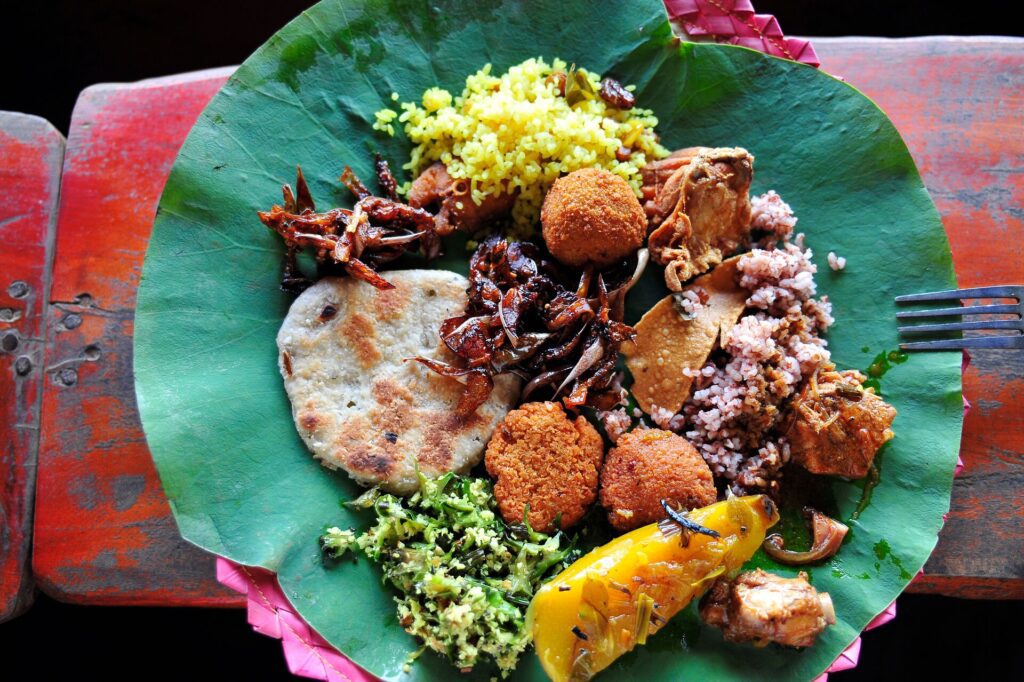

Iconic Main Dishes
Sri Lanka’s signature fare showcases its seasonal, regional produce and cultural influences – and you’ll find it almost everywhere.
Rice and Curry
This everyday staple varies by region and by venue, but you’ll find versions everywhere from modest village cafés to fine-dining restaurants. Typically, a serving includes steamed rice and an assortment of curries – ranging from lentils (parippu) and vegetables, to fish or meat – each with its own distinct spice blends, which may include cinnamon, cardamom, and, of course, curry leaves. Common accompaniments include sambols (spicy relishes), mallung (shredded greens with coconut), and papadams (thin, crispy crackers).
Kottu Roti
This casual classic is especially popular in Colombo and Kandy, where you’ll find it at street-food stalls and in casual eateries. It’s made from chopped godamba roti (an elastic-textured flatbread) stir-fried with vegetables, eggs, and a choice of meats or tofu, all seasoned with spices and sometimes a splash of curry sauce.
Egg Hoppers (Appam)
These bowl-shaped pancakes are eaten at both breakfast and dinner, made from a fermented batter of rice flour and coconut milk. During cooking, an egg is cracked into the centre, resulting in a crispy-edged crêpe with a soft, steamed egg in the middle. Keen to get hands-on? Learn how to make hoppers from a local expert in a village near Ella – part of Adventure World’s Essence of Sri Lanka holiday.


String Hoppers (Idiyappam)
These delicate nests of rice noodles are made by pressing rice flour dough through a mould to create thin strands, then steaming them. Typically served for breakfast or dinner, they’re accompanied by a choice of curries and sambols so you can pick and mix your own flavours.
Lamprais
Especially popular in Colombo, this filling favourite is a legacy of Dutch colonial influence – the name comes from the Dutch lomprijst, meaning “lump of rice”. Traditionally prepared by the Dutch Burgher community, it features yellow rice, two meat curries, frikkadels (meatballs), seeni sambol (caramelised onions), plantain and eggplant – all wrapped in a banana leaf and baked.
Milk Rice (Kiribath)
This ceremonial dish is a symbol of prosperity, served widely across the island and especially on special occasions like New Year’s Day, weddings, and birthdays. It’s made by cooking rice in coconut milk until it’s creamy; then, once it has set, it’s cut into diamond or square shapes and served either sweet or savoury, with condiments like lunu miris (chopped chilli and onion) or jaggery (palm sugar), or as an accompaniment to curry dishes.
Pittu
This cake-like classic is also served either sweet or savoury, at dinner or breakfast, especially in the northern and eastern regions. It consists of a mixture of rice flour and grated coconut, layered in a cylindrical mould and then steamed. The result is a crumbly accompaniment that’s usually served with coconut milk, curries, or sweeteners like kithul (palm syrup).
Taste your way from one hotspot to the next on our 16-day Authentic Sri Lanka holiday, including the south coast’s idyllic beaches, Yala National Park, the Cultural Triangle’s sacred sites, and more.
Must-Try Street Foods and Snacks
These grab-and-go bites are readily available at markets, roadside stalls, train stations and bakeries for a convenient, flavour-packed introduction to Sri Lankan’s casual fare.
Isso Vadai
These spicy, crunchy patties are widely sold by vendors in coastal towns and urban centres. Each is made from a seasoned mix of ground lentils, onions and spices, which is then shaped into flat discs and deep-fried ’til crisp. Before frying, a marinated prawn is pressed into the top of the vadai, adding a seafood twist to the classic lentil snack.
Short Eats (Samosas, Cutlets, Rolls)
‘Short eats’ is a catch-all term for Sri Lanka’s wide variety of savoury pastries and snacks sold in cafés, bakeries and street stalls. These include triangular samosas stuffed with curried vegetables or minced meat; round cutlets made from mashed potato and fish, crumbed and fried; and rolls – thin pancakes filled with spiced meat or vegies, then rolled, breaded and deep-fried. Many Short Eats are served plain, but some cafés offer chilli or tomato-based sauces for dipping.
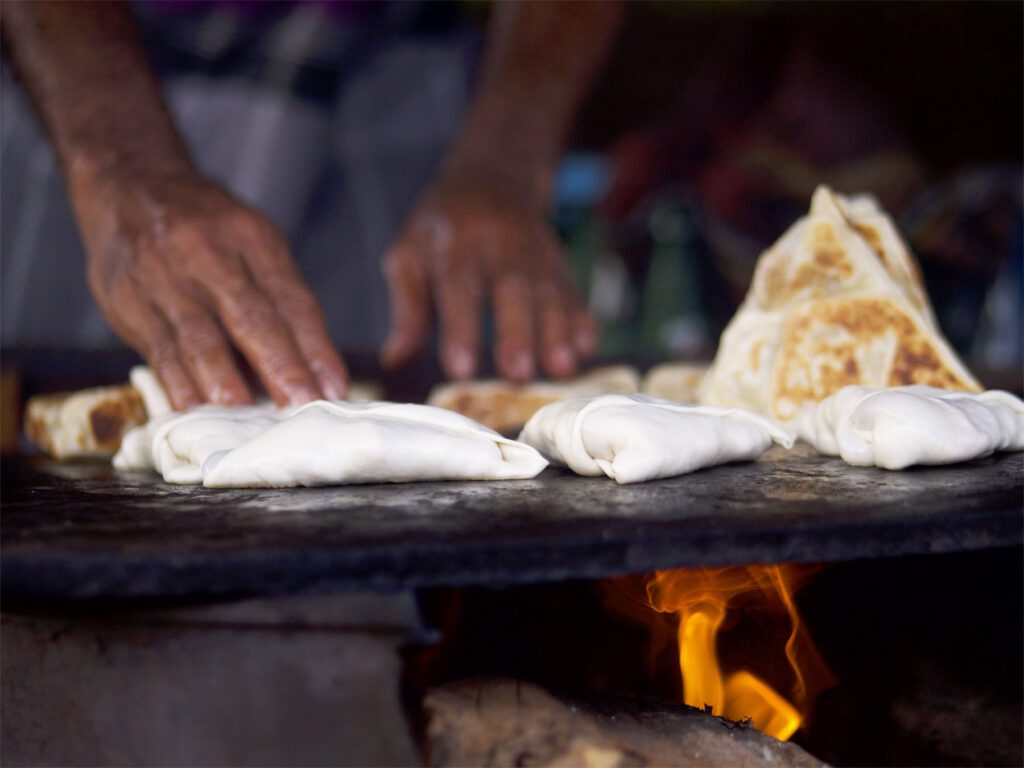

Ulundhu Vadai (Medu Vada)
These golden, doughnut-shaped fritters are made from urad dal (black gram lentils), ground into a batter with curry leaves, onions and spices. The batter is shaped into rings and deep-fried until crisp outside and fluffy inside. A common breakfast or tea-time snack, they’re often served with coconut chutney or sambar – a mild, lentil-based vegie stew.
Coconut Roti with Lunu Miris
Also known as pol roti, this flatbread is made from a mixture of flour and freshly grated coconut, then cooked on a griddle until slightly charred. It’s typically served with lunu miris, a fiery condiment made from crushed red chillies, onions, salt, lime juice, and sometimes, a touch of dried fish.
Cassava Chips
Locally known as manioc chips, these crunchy snacks are made from thinly sliced cassava root, deep-fried until golden and crisp. Often dusted with salt and chilli powder, they’re sold in markets, roadside stands and small grocery shops across the country.
Paratha (Parotta)
Originally from South India, this layered flatbread is made from refined flour, kneaded with oil or ghee, then cooked on a hot griddle until flaky and golden. It’s become a staple in Sri Lankan cuisine, particularly in the north and east, where it’s eaten at breakfast or dinner with dhal, spicy gravy or meat curry – or enjoyed on its own, pan-hot.
Adventure World’s Essence of Sri Lanka holiday is an 11-day immersion in its World Heritage sites, ancient Buddhist capitals and wildlife-rich wilderness.
Curries and Sides Worth Sampling
Curries and sambols form the backbone of Sri Lankan dining, served with rice at nearly every meal. Yet their flavours vary across the country: coastal areas tend to use more chilli, tamarind and dried fish for punchier, spicier combinations, while the central highlands go with subtler spice and coconut milk for a creamier texture.
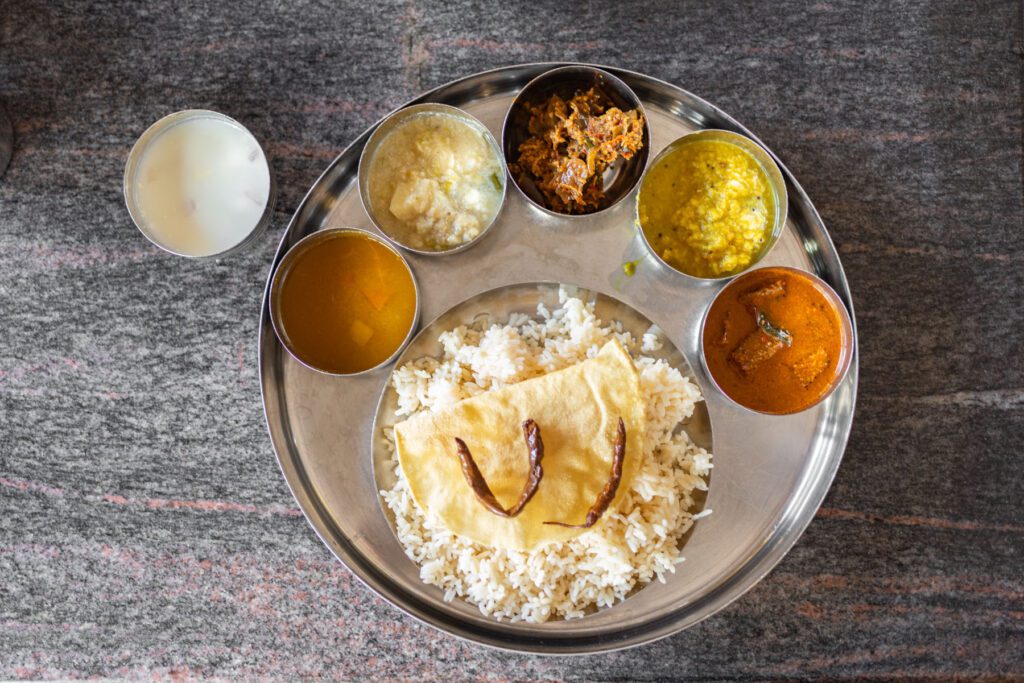

Dhal Curry (Parippu)
One of the most common dishes across the island, and eaten with rice or hoppers, this mild but flavourful curry is made from split red lentils (masoor dhal), softened with onions, garlic, pandan, curry leaves and turmeric. A finishing drizzle of coconut milk brings a creamy texture, while a scattering of mustard seeds and dried red chillies adds gentle heat.
Polos
This curry features young green jackfruit simmered in a thick gravy made from coconut, chilli powder, coriander, turmeric and curry leaves. The jackfruit’s texture is like pulled pork, making it a popular plant-based option – particularly in the western, central and southern provinces, where it’s a fixture at rice-and-curry counters and vegetarian cafés.
Beetroot Curry
Brightly coloured and subtly sweet, this mild dish contains finely sliced beetroot simmered in coconut milk and is gently flavoured with mustard seeds, onions, curry leaves and green chillis. It’s a cooling contrast to spicier dishes and is commonly found across the south and central regions.
Brinjal Moju (Wambatu Moju)
This sweet, tangy and gently spicy eggplant relish is often served at celebrations, especially in the country’s west and northwest. Long strips of deep-fried eggplant are soaked in a marinade of vinegar, sugar, mustard seeds, chilli, curry leaves and green capsicum. While the condiment isn’t super-hot, the vinegar brings some zing.
Gotukola Sambol
Made with finely shredded gotukola (Asiatic pennywort), this raw herby salad is tossed with coconut, lime juice, red onion, green chilli and salt. Refreshing and mildly peppery, it’s commonly eaten with rice and curry in both rural and urban areas, especially in the central and southern areas.
Pol Sambola
Traditionally served with hoppers, string hoppers or coconut roti, this spicy condiment is made from grated coconut, red chilli powder, lime juice, salt and chopped red onion, and is sometimes sharpened with dried fish. And while the heat level varies depending on how much chilli is used, you can expect a bit of a kick.
Adventure World’s 11-day Wildlife of Sri Lanka holiday takes you deep into four iconic wilderness parks for extraordinary sightings of native animals like leopards, elephants and hornbills.
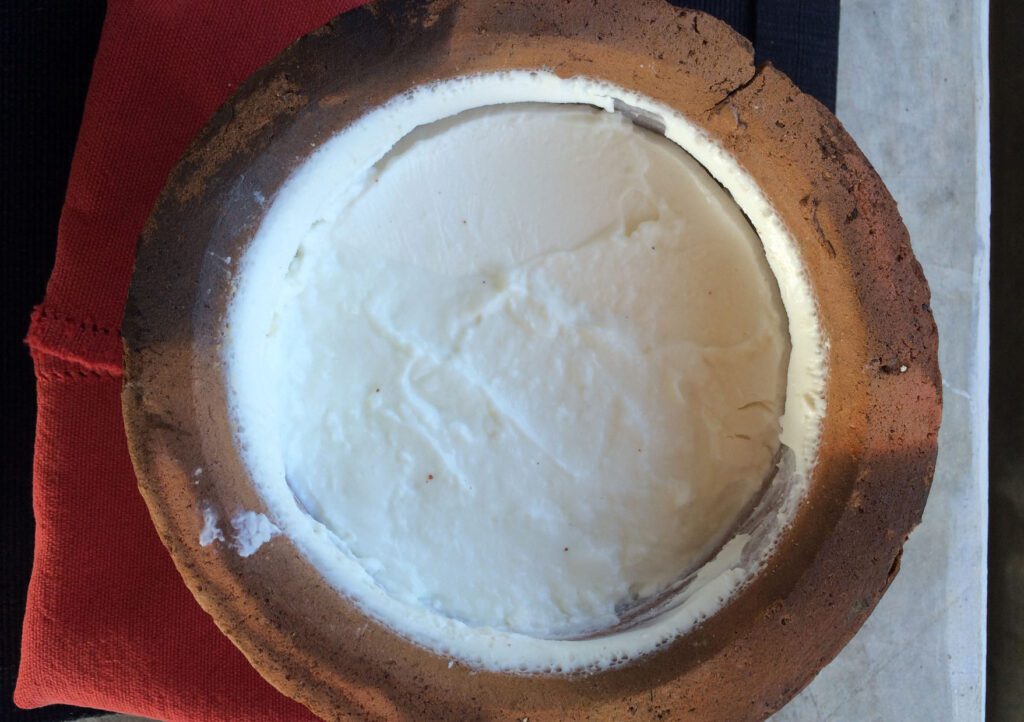

Unique Desserts, Dairy Dishes and Drinks
Sri Lankan sweets are a little lighter than their Western counterparts, often incorporating tropical fruit, rice flour, coconut, or buffalo milk curd rather than heavy creams. And while exploring the tropics can be thirsty work, the island pours a range of sips to wet and refresh your whistle – from naturally sweet coconut water to potent spirits.
Buffalo Curd with Treacle
This tangy-sweet dessert pairs thick curd (made from water buffalo milk) with a drizzle of kithul treacle – the sap of the Caryota urens palm tree, native to Sri Lanka. The curd has a distinctive sourness and firm, silky texture, while the kithul adds caramel notes without being overly sweet. Particularly common in southern Sri Lanka, especially around Matara and Galle, it’s served as a dessert or, more traditionally, as a cooling accompaniment to spicy meals.
Woodapple Juice
Made from the pulp of the woodapple fruit (Limonia acidissima), this thick, tangy drink is especially popular in Colombo and along the southern and eastern coasts. To prepare it, the hard shell is cracked open, and the dark brown pulp is scooped out then blended with jaggery (palm sugar), water, and sometimes a touch of salt. The result is a sweet-sour juice with a gritty texture and fermented aroma that’s both memorable and divisive. Ready to make up your own mind? You’ll find it served chilled at juice stalls, and in small kiosks and markets.
Ceylon Milk Tea
Sri Lanka’s Ceylon tea is world-famous, but milk tea – or kiri teh – is how it’s most often sipped locally. Black tea is brewed strong, then combined with condensed or evaporated milk for sweetness and creaminess. Served hot in teahouses or casual eateries, it’s especially popular in urban areas like Kandy and Colombo, where it’s paired with short eats or biscuits.
King Coconut
Known locally as thambili, king coconuts are a bright orange variety grown almost exclusively in Sri Lanka, harvested in the wet and intermediate zones of the southern, western and central provinces. Smaller and sweeter than green coconuts, they contain mildly nutty water that’s naturally rich in electrolytes – and usually sipped straight from the husk through a straw.
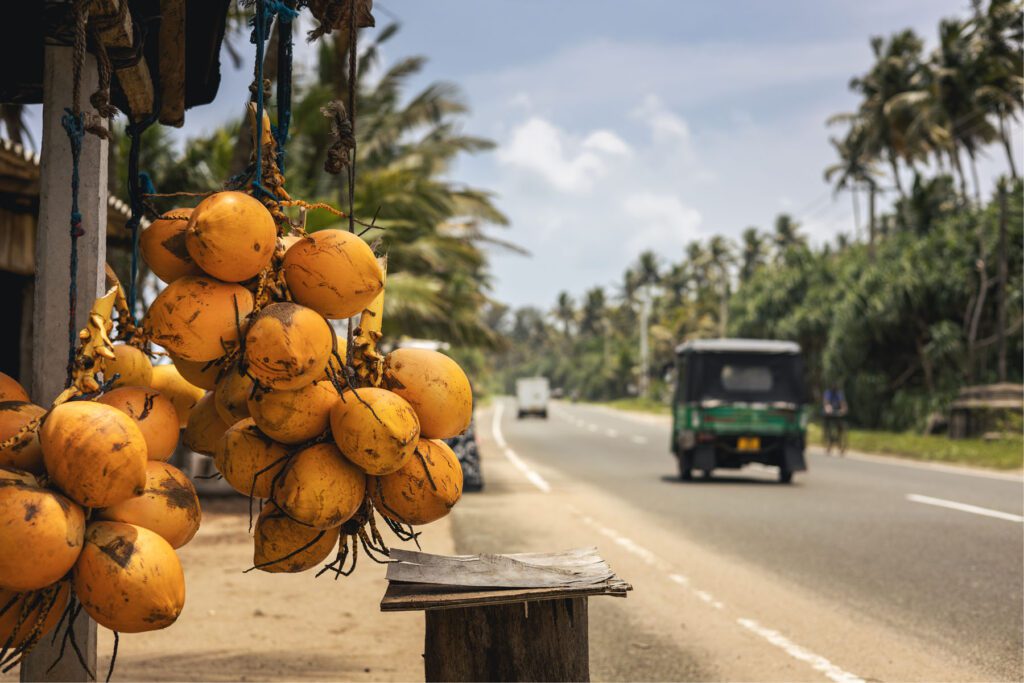

Toddy
This mildly alcoholic drink is tapped from the sap of the coconut or kithul palm flower, traditionally collected by skilled climbers known as ‘toddy tappers’. Within hours of being extracted, the sap begins to ferment, reaching alcohol levels of around 4 to 5 per cent. Toddy is common in coastal and rural areas, often drunk fresh in rural areas and ‘toddy taverns’, and also used to distil stronger spirits like arrack.
Arrack Cocktails
Arrack is a high-proof spirit distilled from the fermented sap of the coconut flower – and occasionally from the kithul palm. Clear and potent with earthy, slightly floral notes, it’s been produced locally for centuries and ranges from rustic homebrews to refined, aged varieties. While locals often drink it neat or with soda water, premium versions star in cocktails across Colombo, Galle and Kandy, including arrack sours, ginger-based highballs, and tropical blends with lime, passionfruit or pineapple.
Kola Kanda
This warm herbal porridge is enjoyed at breakfast, especially in Sinhalese Buddhist communities, and you’ll occasionally find it in Ayurvedic cafés or wellness retreats focused on traditional Sinhalese healing. It’s made from rice, coconut milk and an infusion of medicinal leafy greens like gotukola, iriveriya or karapincha. While savoury in taste, its slight bitterness is balanced out by the coconut milk.
Tamarind Juice
Locally known as siyambala diya, this tart, slightly sweet beverage is made by steeping the pulp of tamarind pods in water and straining it to remove seeds and fibres. Often flavoured with jaggery, salt, or chilli, you’ll find it served in cafés and some Ayurvedic restaurants, especially during the hotter months.
So, when should you visit Sri Lanka? Find out the best times for weather and crowds, by season and region, in our comprehensive Sri Lanka travel guide.
Vegetarian and Vegan Options
Thanks to Sri Lanka’s Buddhist and Hindu traditions, vegetarian food is widely available across the island – especially in Tamil-majority regions of the north and east, including Jaffna, Kilinochchi and Batticaloa. In fact, most eateries – from roadside cafés to mid-range restaurants – serve plant-based staples daily, with many dishes naturally meat-free and built around seasonal vegetables, pulses, curries, lentils, jackfruit, leafy greens, rice and coconut.
Common Plant-Based Dishes
Must-try vegetarian staples include parippu, a curry made with red lentils, coconut milk and curry leaves, and polos – a curry that uses young jackfruit as a meaty stand-in. You’ll also find brinjal moju (or wambatu moju), a tangy-sweet eggplant relish; gotukola sambol, a refreshing mix of shredded pennywort leaves, coconut and lime; and pol sambola, a spicy coconut sambol. Each of these dishes is usually served with string hoppers, rice or pittu, and can be found in all manner of eateries across the island.
Hidden Non-Veg Ingredients to Watch For
Even dishes that seem to be vegetarian may include animal-derived ingredients. Dried fish is often added to sambols and vegetable curries for seasoning (especially in Sinhalese cooking), and some lentil-based dishes are flavoured with fish or meat broth. Ghee (clarified butter) or milk may be used in rice dishes and desserts, and eggs are sometimes included in breads like paratha. If you’re strictly vegan or vegetarian, confirm ingredients directly with the cook.
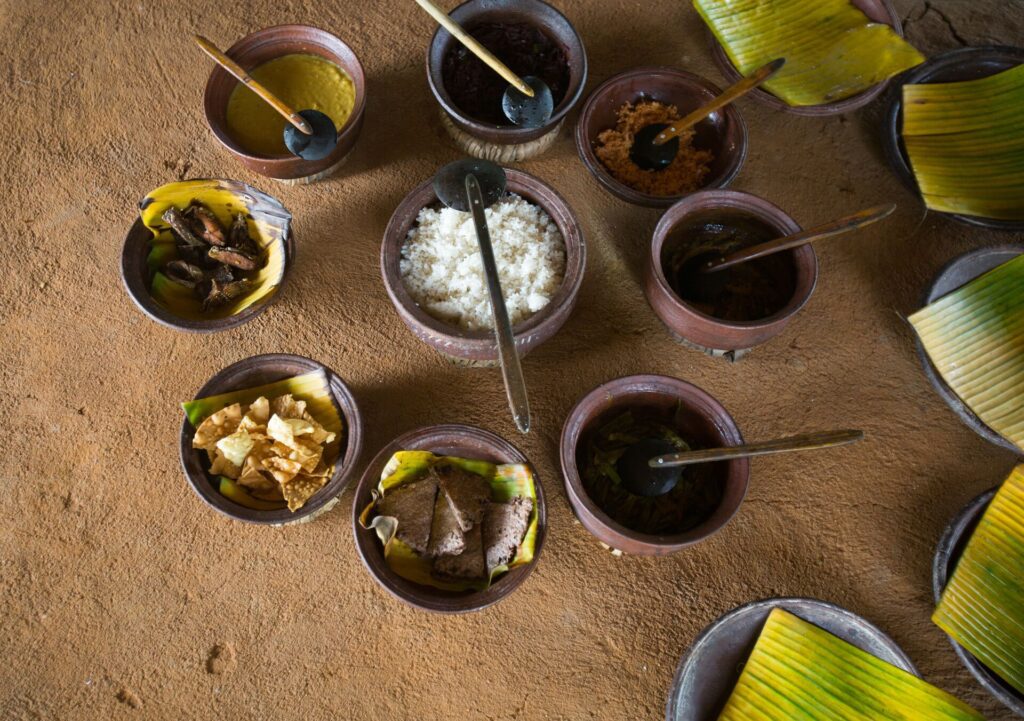

Final Tips for Food Lovers Visiting Sri Lanka
Make the most of your Sri Lankan culinary adventure with these practical hints…
- Make Travel Matter. Keep an eye out for authentic experiences that deepen your connection with the community – and give back to it. For example, when you visit Sigiriya on Adventure World’s Authentic Sri Lanka holiday, you’ll support women-led rural food tourism by learning to cook with a local family. It’s just one way to travel with purpose on this welcoming island – explore our full range of Sri Lanka holidays for more feel-good options.
- Fine-dine in Colombo. To experience the capital’s top culinary talent and service, reserve a table at lauded eateries like Avartana, Ministry of Crab, Upali’s, and The Gallery Café.
- Speak up. English is widely spoken in tourist areas, but a few Sinhala or Tamil phrases can go a long way. Say thank you with “Istuti” (Sinhala) or “Nandri” (Tamil). To say something is delicious, try “Rasai” in Sinhala (meaning “tasty” or “flavourful”) or “Rusiyaa irukku” in Tamil (meaning “it is tasty”).
- Know how to pay. Tipping is customary in restaurants – 10 to 15 per cent is usually appropriate. Credit cards are accepted in cities and major towns, but carry cash for tuk-tuks, market stalls and village vendors.
- Be sip-smart. Alcohol is legal for folks over 21, but it may be unavailable in small towns and smaller guesthouses. Plus, it’s restricted on certain religious holidays – including on the monthly full-moon Poya Days, when bars and bottle-shops may be closed.
- Eat with your hands. Cutlery is widely available, but many locals get hands-on – especially with rice-based meals like curry, kiribath or kottu roti. Always use your right hand and eat only with your fingertips
